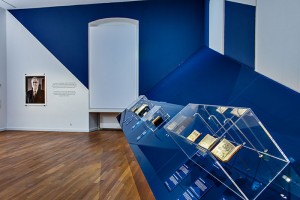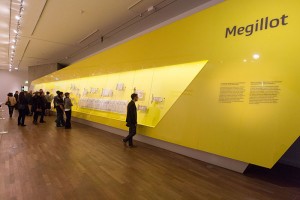An Interview with René Braginsky
When did you start collecting and how large is your collection?
René Braginsky: I started collecting books more than twenty years ago. It was my son’s Bar Mitzvah, and I was looking for an illustrated blessing for the celebration. Since I could not find one, we made do with a copy. For his wedding, however, we were able to reproduce a blessing from our own collection. As I slowly acquired a taste for collecting, I bought more objects, and of increasingly quality, whenever possible. A good friend of mine, an older collector, encouraged me. The Judaica collection now comprises more than 700 pieces: books mainly, but also illustrated wedding contracts and Esther scrolls.
What motivates you to collect Hebrew manuscripts? Do you collect with a specific objective or mission in view?

Interior view of the special exhibition “The Creation of the World. Illustrated Manuscripts from the Braginsky Collection” © Jewish Museum Berlin, photo: Martin Adam
I’m interested, first and foremost, in the direct connection with Jewish history, with my view of Jewish history. I find the sheer variety of illustrations fascinating, as well as the regional and national influences they display. Jewish books in Germany are primarily German books, just as Jewish books from Spain are primarily Spanish and those from Morocco Moroccan. Jews lived in diverse regions, in a diaspora, and the illustrations in the books reflect this. And these old books so full of erudition bring me peace and make me confident, too, that whatever is really important will always survive. The mission, if there is such a thing, is my wish to share them freely, instead of hiding these treasures from the world. That is why we published websites (braginskycollection.com und braginskycollection.ch) , put two iPad apps online (Braginsky Collection und Braginsky Collection Berlin) and chose to exhibit a part of our collection in Berlin, for the fifth time. Over the years, the exhibitions and online sources have enabled tens of thousands of people all over the world—Jews and non-Jews —to share our enjoyment of the collection.
Do you believe the market for collectors of Judaica and Hebrew manuscripts has changed over the last few decades? Have you come across any counterfeiters or crooked dealers?
The books have not become cheaper, at least not the really good books. But the not so rare books are often less expensive, while the prices for unique editions have risen. The trade in Judaica is part of the art trade, so there will always be disreputable dealers around. I try to minimize the risks by working exclusively with a limited number of agents and consultants who know me and whom I can trust. Plus I have been collecting for a good many years and I can generally trust my gut feeling.
Do you go about collecting differently now than you used to?
Perhaps my desire to acquire certain objects is no longer as strong as it used to be, not least because the collection is already quite extensive as it is. But I am an atypical collector; I’ve always been comfortable knowing that there are pieces I won’t ever feel compelled to buy. What has changed over time is the composition of the collection. It has branched out into subsections, such as wedding contracts or the Esther scrolls, for example, or books by certain artists from certain places. The collection has grown and taken shape.
Does your family share your passion for collecting?
Above all, our son takes a great interest in the collection. He appreciates these valuable testimonies to Jewish history and Jewish intellectual life maybe even more than I do, and he also understands them better than I do.
Which objects in your collection aare you particularly attached to?
Every object has its own story to tell, so it’s hard to say. The oldest manuscript, a halakhic text written in the late thirteenth century, perhaps in Switzerland, is a unique treasure and still most impressive. The Mishneh Torah manuscript is a valuable book of German origin [nicht lieber: in German language? Deutschland gab’s ja damals noch nicht] from the year 1355. It contains textual variants that are not otherwise known, as well as the full text of this major legal work by Moses Maimonides, including certain parts about the Messiah that generally used to be censored. Another particularly important piece is the earliest known illustrated Esther scroll from 1564, written by a Jewish woman in Venice. Then there is a magnificent manuscript from a later period, a Pesach Haggadah, penned by a man, and illustrated by a woman, Charlotte von Rothschild, in Frankfurt am Main in 1842. It is the only known Hebrew manuscript from this time to have been painted by a woman.
Where do you see your collection in 100 years?
TThis is a difficult question and one I’m asked again and again. Ultimately, the decision will rest with our son. I’ve often emphasized that I’m not interested in leaving behind an institution, such as a museum or a special library. Basically, we can only ever be temporary custodians of such treasures. On the other hand, collecting is still a lot of fun so I’ll continue to buy new pieces now and then, in the years to come. Collecting is not so much a hobby as a way of life.
Mirjam Wenzel and Michaela Roßberg, Media
P.S. Precious manuscripts of this private collection are shown in the special exhibition “The Creation of the World. Illustrated Manuscripts from the Braginsky Collection” at the Jewish Museum Berlin.
